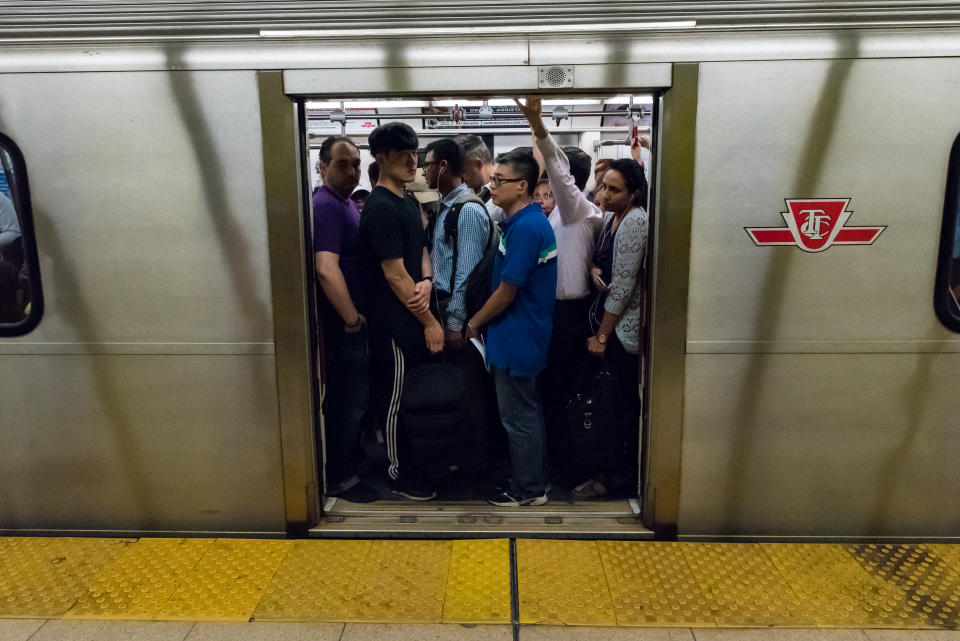Taking steps to protect your health while commuting

Yahoo News Canada is committed to providing our readers with the most accurate and recent information on all things coronavirus. We know things change quickly, including some possible information in this story. For the latest on COVID-19, we encourage our readers to consult online resources like Canada’s public health website, World Health Organization, as well as our own Yahoo Canada homepage.
People who regularly use public transit in their commute to work or school might be feeling anxious about whether they’re at greater risk of contracting the coronavirus. While the risk in Canada remains low, Health Canada has encouraged people to consider changing their behaviours and routines to reduce the risk of infection. This includes reducing exposure to crowded places. One suggestion includes getting places by public transit outside of rush hour, when there’s a large increase in crowds.
Many transit systems across the country are closely monitoring the coronavirus outbreak, which was recently labelled a pandemic, and remain in constant contact with regional health authorities.
In Vancouver, TransLink spokesperson Ben Murphy said in a statement that when it comes to the company’s response to COVID-19, they are following the lead of health officials. While they haven’t been directed to make any operational changes, the transit company is taking steps to keep things clean to reduce any potential risk of viral spread.
Murphy noted that stations and bus loops across the system are cleaned once a day, detailing the many surfaces that are wiped down with disinfectant. These include stair and escalator handrails, elevator buttons, door handles, fare gates, vending machines, garbage handles, benches, seats, emergency cabinets and emergency phones. SkyTrain cars are cleaned overnight and receive a disinfectant wipe down of poles, seats, ceilings, handles, windows, sills, and other surfaces within the cars. The system’s entire bus and SeaBus fleet are being sprayed using a strong disinfectant each week, which comes in addition to daily cleaning schedules, while shared ride service HandyDART vehicles are disinfected twice per week in addition to daily cleaning schedules.
In Toronto, TTC spokesperson Hayley Waldman says extensive cleaning is done on all vehicles daily, though she admits they have stepped up their cleaning since late January.
“We pay special attention to areas that are considered high touch, like areas you’d grab onto,” she tells Yahoo Canada. “We are also providing special cleaning for our operator areas.”
They are also encouraging customers to practice all the health suggestions advised by public health organizations and professionals, like washing hands frequently, coughing or sneezing into your elbow and staying home if you’re feeling sick.
Tom Koch, an adjunct professor with the Department of Geography at the University of British Columbia says at the present time, commuters should not be overly concerned about their daily trips since the level of viral incidence in the population-at-large is still not high.
“People are being cautious about sneezing or coughing into their sleeves, washing their hands when they get home, not rubbing their eyes if they can refrain from it,” he says.
Alison Thompson, an associate professor in the faculty of pharmacy at the University of Toronto says during the Spanish flu outbreak in 1918, an ad appeared in a local newspaper promoting bicycles as an alternative to streetcars.
It read: Get away from stuffy, overcrowded streetcars with their danger of contagion. Ride a bicycle through the pure, fresh air.
“People have been trying to avoid mass transit in these kinds of situations for a long time,” she says.
She says that social distancing, by keeping at least a meter away from other people is a good idea if possible, but admits that can be challenging during rush hour. It helps if a window on a bus or streetcar can be left open to circulate fresh air.
Outside of that, she says masks aren’t terribly effective unless you’re already sick, but avoid touching your face and keep your hands clean.
“Wash your hands after being on public transit, before you do anything else, or use hand sanitizer as a backup,” she says. “Gloves are ideal but we’re getting into warmer weather so it might look a little strange.”

 Yahoo Finance
Yahoo Finance 